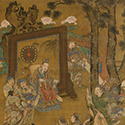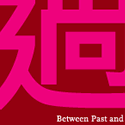|
|
| Show All 70 Results (Text Only) |
|
| Altered States: Zhang Huan |
|
| Asia Society
|
"Asia Society Museum presents the first-ever museum retrospective of Zhang Huan, one of the most important and widely recognized Chinese artists working in the United States and China. Altered States: Zhang Huan includes 55 of the artist's major works produced over the past 15 years in Beijing, New York, and Shanghai, including photographs and sculpture." Uses Flash.
Go to Museum Resource: http://sites.asiasociety.org/arts/zhanghuan/ | |
|
|
| Art and China's Revolution |
|
| Asia Society
|
"Art and China’s Revolution reflects upon one of the most tumultuous and catastrophic periods in recent Chinese history⎯the three decades following the establishment of the Peoples Republic of China in 1949. During this time, the government led by Mao Zedong sought to modernize China across all aspects of society, a process that included suppressing or destroying much of traditional culture. The government also sought to create a new visual culture to communicate its goals and ideology to the Chinese people. Artists were encouraged to create art that reflected the revolutionary spirit of the time, in Mao’s words, to create art for the people. The impact of this directive on artists and art making was enormous. ... Until now, little effort has been made to take account of this period, during which art and politics were so closely intertwined. ... This exhibition marks a first attempt, which we hope will be the start of many, to examine these artistic developments within an historical framework that prompts a discussion of their impact on Chinese culture today." With extensive text and images of several works from the exhibition, as well as an interactive timeline of Chinese art from 1949 to 1979. Uses Flash.
Go to Museum Resource: http://sites.asiasociety.org/chinarevo/ | |
|
|
| The Artist as Collector: Masterpieces of Chinese Painting from the C. C. Wang Family Collection |
|
| The Metropolitan Museum of Art
|
Online presentation of a 1999-2000 exhibition that "illuminates the entire tradition of scholar painting from its birth and early development in the Song and Yuan dynasties (10th to 14th century) to its later transformation and elaboration during the Ming and Qing dynasties (14th to 20th century)." With images of 14 related artworks dating from the 10th century to 1711.
Go to Museum Resource: https://www.metmuseum.org/exhibitions/listings/1999/chinese-painting | |
|
|
| Between Past and Future: New Photography and Video from China |
|
| Asia Society
|
Online presentation of a 2004 exhibition that takes "a comprehensive look at the innovative photo and video art produced since the mid-1990s in China." Featured topics: History and Memory; Reimagining the Body; People and Places; and Performing the Self.
Go to Museum Resource: http://sites.asiasociety.org/arts/past_future/index.html | |
|
|
| Bridging East and West: The Chinese Diaspora and Lin Yutang |
|
| The Metropolitan Museum of Art
|
Online presentation of a 2008 exhibition featuring "43 paintings and calligraphies by 19 leading Chinese artists of the mid-20th century." With images of 12 artworks.
Go to Museum Resource: https://www.metmuseum.org/exhibitions/listings/2007/lin-yutang | |
|
|
| Buddhist Cave Temple Sculpture |
|
| Victoria and Albert Museum
|
The Central Asian tradition of building such complexes was been practiced for centuries, primarily with Imperial sponsorship in the Northern regions, where Buddhism first took hold. The very act of creating these vast monuments, hollowed out from rock faces and decorated so lavishly within, was considered an act of 'piety' resulting in the accrual of merit, which in Buddhism is accumulated as a result of good deeds, acts or thoughts. This merit is then carried over to later in life or to a person's next birth. The sculptures and paintings also functioned as an important focus for worship and as symbolic links between the worldly and heavenly realms. People would have travelled great distances to see them and to worship and make offerings before them.
Go to Museum Resource: http://www.vam.ac.uk/content/articles/c/chinese-buddhist-cave-temple-sculpture/ | |
|
|
| Cai Guo-Qiang: I Want to Believe |
|
| Guggenheim Museum
|
"Cai Guo-Qiang has literally exploded the accepted parameters of art making in our time. Drawing freely from ancient mythology, military history, Taoist cosmology, extraterrestrial observations, Maoist revolutionary tactics, Buddhist philosophy, gunpowder-related technology, Chinese medicine, and methods of terrorist violence, Cai’s art is a form of social energy, constantly mutable, linking what he refers to as 'the seen and unseen worlds.' This retrospective presents the full spectrum of the artist’s protean, multimedia art in all its conceptual complexity." With video documentation and an online exhibition of selected works. See also: Teaching Materials.
Go to Museum Resource: https://www.guggenheim.org/exhibition/cai-guo-qiang-i-want-to-believe-2 | |
|
|
| Cai Guo-Qiang on the Roof: Transparent Monument |
|
| The Metropolitan Museum of Art
|
Online presentation of a 2006 installation at the Metropolitan Museum by the contemporary Chinese-born artist Cai Guo-Qiang, who is "known for his elaborate sculpture installations and gunpowder projects." With 7 images from the rooftop installation.
Go to Museum Resource: https://www.metmuseum.org/exhibitions/listings/2006/cai-guo-qiang | |
|
|
|
| Show All 70 Results (Text Only) |









